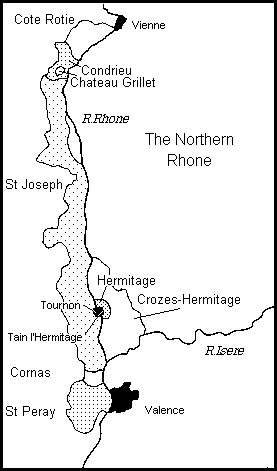Copyright
DKOP L.L.C.
© 1999-2016
• All rights reserved.*
..
|
Rhone
River Region
|
|
|
The Rhone river valley
in southeastern France
is a grape growing and wine producing area famed for its The Northern Rhone is a steep river
valley cutting through the central massif with vines growing on
granite soils along the protected western slopes, with a south or
south-east aspect. Terracing, because of the slope, and "wig-wams"
or "tepees" for vine training are common because of the Mistral
wind (some areas cannot be planted). Climate like Beaujolais is
southern continental with cold winters & shortish summers. Traditional
open vat fermentation with pumping over & wood ageing for 2
years is normal practice. Soil is principally granite.
CH GRILLET: This is the smallest Appellation Controllee district in France. It is one of only 2 districts that are privately owned. One vineyard of 3 acres giving a yield of 32 H/H of white Viognier grape, with an output of 1,000 cases in its own yellow-brown bottles. Wine is fermented in enamel vats at 25°C until malolactic fermentation is complete, and then spends 6 months in old oak cask, bottled after 15 months in bottlings of 2,000. Prices are high because of its rarity. Keeps10 years. CONDRIEU: This region produces a white wine from the Viognier grape. Traditionally the wine receives a period of aging in oak barrels, The wine should be consumed while young or at least within the first 4 or 5 years from the vintage. . Appellation Controllee regulations do not set a maximum residual sugar content so the level of sweetness can vary between producers. The wines may have hints of ginger and rose in the nose and flavors of stone fruits like peach and apricot in the taste. Leading producers are Georges Verney (best quality) and Guigal (for quantity). ST JOSEPH is a series of small hills (not all of which are suitable for vines) with 640 hectares under vines. The size of the region has grown from on 240 hectares in 1972. That is the year that the Appellation Controllee rules changed. The red wine from St. Joseph is 100% Syrah. It is a lighter wine than Chateauneuf du Pape because of the soil structure which as sand and gravel in the rocky granite. Some of the white wine is made from Marsanne and Rousanne. There are 25 communes in the region. The red wine should age about 5 years before it is consumed. Reds will last another 10 years or beyond. The white wines should be consumed when they are young. The best of the St. Joseph wines come from the slopes behind Tournon (opposite Croze-Hermitage) where the the steep slopes on the eastern side of the valley come to an end. Overall production is in the range of 100,000 cases with 95% of that total being red. CORNAS: This is a region of 85 hectares in 1995. It is a very steeply sloped area that is difficult to work and harvest. Syrah is the only authorized grape variety. Fruit from the young vines is often blendied into 'Cotes du Rhone' regional wines while fruit from the mature vines (30 to 60 years old) goes into Cornas. These wines can take a decade or more to mature. ST PERAY: This region produces wines that rarely get exported from France. The primary wine product is a non-vintage sparkling wine made mostly from Marsanne with a small amount of Rousanne blended in. It is produced using the tradtional method found in the Champagne region (methode champenoise). HERMITAGE: The Appellation consists of one domed hill of 125 hectares and is named from the hilltop chapel that was once home to a Knight Crusader. Red from Syrah on granite soil (33,000cases output) and white on sandy soil (11,000 cases). Red is aged 15 months to 2 years (3yrs by Chapoutier) drink from 10 years!; white is from Marsanne and Rousanne [Chapoutier = 100% Marsanne;Jaboulet = 55/45% Marsanne/Rousanne]. Hermitage & Cote Rotie were superb value but their prices have soared in the last few years.St Joseph, Cornas & Croez-Hermitage are still affordable. CROZES HERMITAGE, (AC 1937) satellite to Hermitage producing 94% red from Syrah and 6% white totalling 6.6 million bottles p.a.from 1200 hectares (having grown from 450 hectares in the last 25 years). 60% of all N.Rhone output comes from Croze Hermitage.The largest producer is the Co- operative Caves de Tain (established 1933) with 700 members and 1000 hectares of vineyards. The Co-operative controls 65% of Crozes-Hermitage, 25%of Hermitage, 15% of Cornas, 35% of St Peray and 11% of St Joseph(ie 50% of the wine of northern Rhone). A second Co-operative (Caves des Clairmonts) was established in the '70s and in contrast, with only four families as members, must be the smallest French co-operative. The number of Domains has increased from 10 in 1980 to 38 in 1994. Increased competition and European Union and local funding of 25million francs since 1978 has contributed to a steady improvement in the quality of wine. The better reds are from Dom de Thalabert and Jaboulet; the better white is Mule Blanc. |
|
 red
wines. The region is just under 150 miles long (north to
south) and lies between the cities of Lyon in the north and Avignon
in the south. There are 16 specific appellations that cover
an area of more than 41,000 hectares. All qualities of wine
are produced here from
red
wines. The region is just under 150 miles long (north to
south) and lies between the cities of Lyon in the north and Avignon
in the south. There are 16 specific appellations that cover
an area of more than 41,000 hectares. All qualities of wine
are produced here from